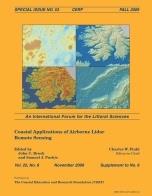Coral reefs represent one of the most irregular substrates in the marine environment. This roughness or topographic complexity is an important structural characteristic of reef habitats that affects a number of ecological and environmental attributes, including species diversity and water circulation. Little is known about the range of topographic complexity exhibited within a reef or between different reef systems. The objective of this study was to quantify topographic complexity for a 5-km x 5-km reefscape along the northern Florida Keys reef tract, over spatial scales ranging from meters to hundreds of meters. The underlying dataset was a 1-m spatial resolution, digital elevation model constructed from lidar measurements. Topographic complexity was quantified using a fractal algorithm, which provided a multi-scale characterization of reef roughness. The computed fractal dimensions (D) are a measure of substrate irregularity and are bounded between values of 2 and 3. Spatial patterns in D were positively correlated with known reef zonation in the area. Landward regions of the study site contain relatively smooth (D ≈ 2.35) flat-topped patch reefs, which give way to rougher (D ≈ 2.5), deep, knoll-shaped patch reefs. The seaward boundary contains a mixture of substrate features, including discontinuous shelf-edge reefs, and exhibits a corresponding range of roughness values (2.28 ≤ D ≤ 2.61).
How to translate text using browser tools
1 November 2009
A Multiscale Analysis of Coral Reef Topographic Complexity Using Lidar-Derived Bathymetry
David G. Zawada,
John C. Brock
ACCESS THE FULL ARTICLE

Journal of Coastal Research
Vol. 2009 • No. 10053
Fall 2009
Vol. 2009 • No. 10053
Fall 2009
coral reef roughness
fractal dimension
reef segmentation
zonation




